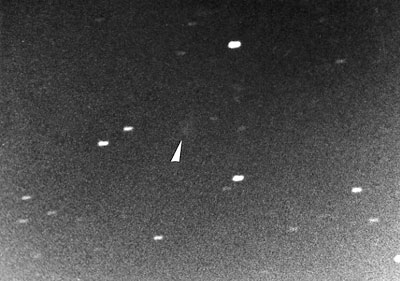A story of the mysterious comet Tuttle-Giacobini-Kresak
I have written in an earlier report that Dr. Kresak of Czechoslovakia
(presently Slovak Republic)visually re-discovered this long-lost comet
in 1951 while searching for a new comet. The story here is about very unusual
and amazing developments and Geisei's comet telescope also played a prominent
role in it.
The mirror of Geisei's comet telescope was made by pouring
melted glass into a mold, which is commonly believed to be worse than blue
plate glass. The equatorial mounting to support this telescope also turned
out to be a lemon built by N company with a periodic error of as much as
40". I was just able to overcome the deficiencies of this telescope
only with my skill and experience. In spite of a trying and hopeless situation
like this, I was full of passion and enthusiasm for observing with the
newly installed comet telescope.
Strange, new developments all started in 1973. For the 1973
return of Comet Tuttle-Giacobini-Kresak the prediction of the positions
had been published in BAA Handbook by Milbourne and others. It was predicted
that the comet would pass perihelion on May 29 and reach a maximum magnitude
of 14 from May to June. In mid June, however, we were surprised by a telegram
from Smithsonian to report that the comet had brightened to 4th magnitude
displaying a substantial tail. This made Dr. Marsden even wonder if this
was a completely new comet with a similar orbit and requested Japanese
observers and others to verify it. Unfortunately, we were in the middle
of the rainy season and nobody in Japan was able to observe this comet.
This "new comet" turned out to be Tuttle-Giacobini-Kresak in
outburst and it became 10 magnitudes brighter than BAA's prediction. Dr.
Kresak, a theorist and one of the re-discoverers of this comet, expressed
his view that the comet might have lost most of its energy by this outburst.
Because of this, Dr. Marsden published his prediction for the comet's 1978
return in BAA Handbook that it would reach incredibly faint 20.4 magnitude.
Furthermore, the comet would have to be observed in the worst possible
conditions; low altitudes in the predawn sky. This would certainly discourage
observers from searching for it.
Against such odds there was one telescope searching for the
approaching comet under freezing pre-dawn December skies hoping for the
comet's outburst. It is, of course, Geisei's newly installed comet telescope.
"The comet must have regained some brightness", I believed and
turned the telescope to low eastern skies in the approaching twilight
Looking into the finderscope, I was stunned. Venus at its
maximum brightness was glaring at the center of the field. Though I thought
it would be impossible to photograph the comet, I made short exposures
one after another, thinking just in case... It was several days later that
I found the comet was captured on one of the plates. I was able to determine
its position away from Venus and my earlier measurements became useful.
This was probably the first achievement by the comet telescope. At the
same time I came to believe strongly that efforts, though not promising,
could pay off.
I have found only one photographic plate with the comet on
it. Across the field it is hazy due to a ghost image of Venus. I wondered
what Dr. Kresak and the Japanese astronomer Mr. H thought of the comet's
recovery by Geisei. They had expressed a pessimistic view about finding
the comet.
41P/Tuttle-Giacobini-Kresak
1978UT RA (2000.0) Dec m1
Dec.11.84583 14 39 34.21 -11 38 18.8 14.9 372

41P/Tuttle-Giacobini-Kresak
16-minute exposure from 05:10, December 12, 1978 J.S.T.
40cm f/5 reflector, 103a-O photographic plate

